Consumer Behavior Report: Smart TV Market and Consumer Decision Making
VerifiedAdded on 2022/10/12
|12
|3879
|228
Report
AI Summary
This report provides a comprehensive analysis of consumer behavior in the context of smart TV purchases. It begins by outlining the consumer decision-making process, highlighting the influence of psychological, economic, and environmental factors. The report then delves into the purchase situation and target market profile, detailing how external influences and market segmentation strategies impact consumer choices. A significant portion of the report focuses on the factors affecting customer decision-making, including the varying interfaces and features of different smart TV platforms, and the stages consumers go through before making a purchase. The report also examines demographic, psychographic, and behavioral segmentation, exploring how personal factors such as lifecycle stage, occupation, economic circumstances, lifestyle, and personality influence consumer preferences. Finally, the report offers recommendations and strategies for marketers to effectively target and engage with consumers in the smart TV market, considering the various factors that shape their buying behavior.

CONSUMER BEHAVIOR
Running Head: CONSUMER BEHAVIOR 0
Running Head: CONSUMER BEHAVIOR 0
Paraphrase This Document
Need a fresh take? Get an instant paraphrase of this document with our AI Paraphraser
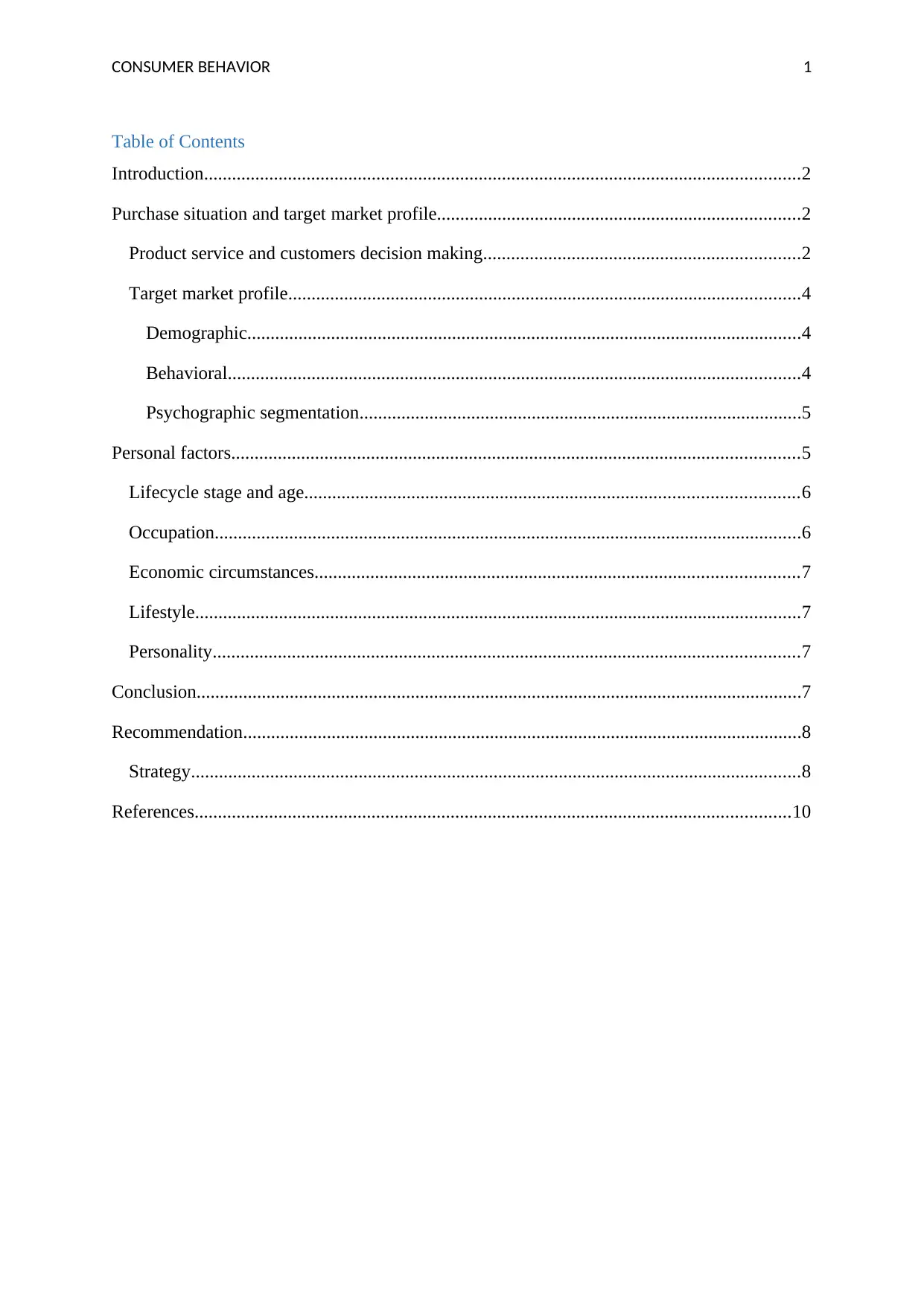
CONSUMER BEHAVIOR 1
Table of Contents
Introduction................................................................................................................................2
Purchase situation and target market profile..............................................................................2
Product service and customers decision making....................................................................2
Target market profile..............................................................................................................4
Demographic.......................................................................................................................4
Behavioral...........................................................................................................................4
Psychographic segmentation...............................................................................................5
Personal factors..........................................................................................................................5
Lifecycle stage and age..........................................................................................................6
Occupation..............................................................................................................................6
Economic circumstances........................................................................................................7
Lifestyle..................................................................................................................................7
Personality..............................................................................................................................7
Conclusion..................................................................................................................................7
Recommendation........................................................................................................................8
Strategy...................................................................................................................................8
References................................................................................................................................10
Table of Contents
Introduction................................................................................................................................2
Purchase situation and target market profile..............................................................................2
Product service and customers decision making....................................................................2
Target market profile..............................................................................................................4
Demographic.......................................................................................................................4
Behavioral...........................................................................................................................4
Psychographic segmentation...............................................................................................5
Personal factors..........................................................................................................................5
Lifecycle stage and age..........................................................................................................6
Occupation..............................................................................................................................6
Economic circumstances........................................................................................................7
Lifestyle..................................................................................................................................7
Personality..............................................................................................................................7
Conclusion..................................................................................................................................7
Recommendation........................................................................................................................8
Strategy...................................................................................................................................8
References................................................................................................................................10
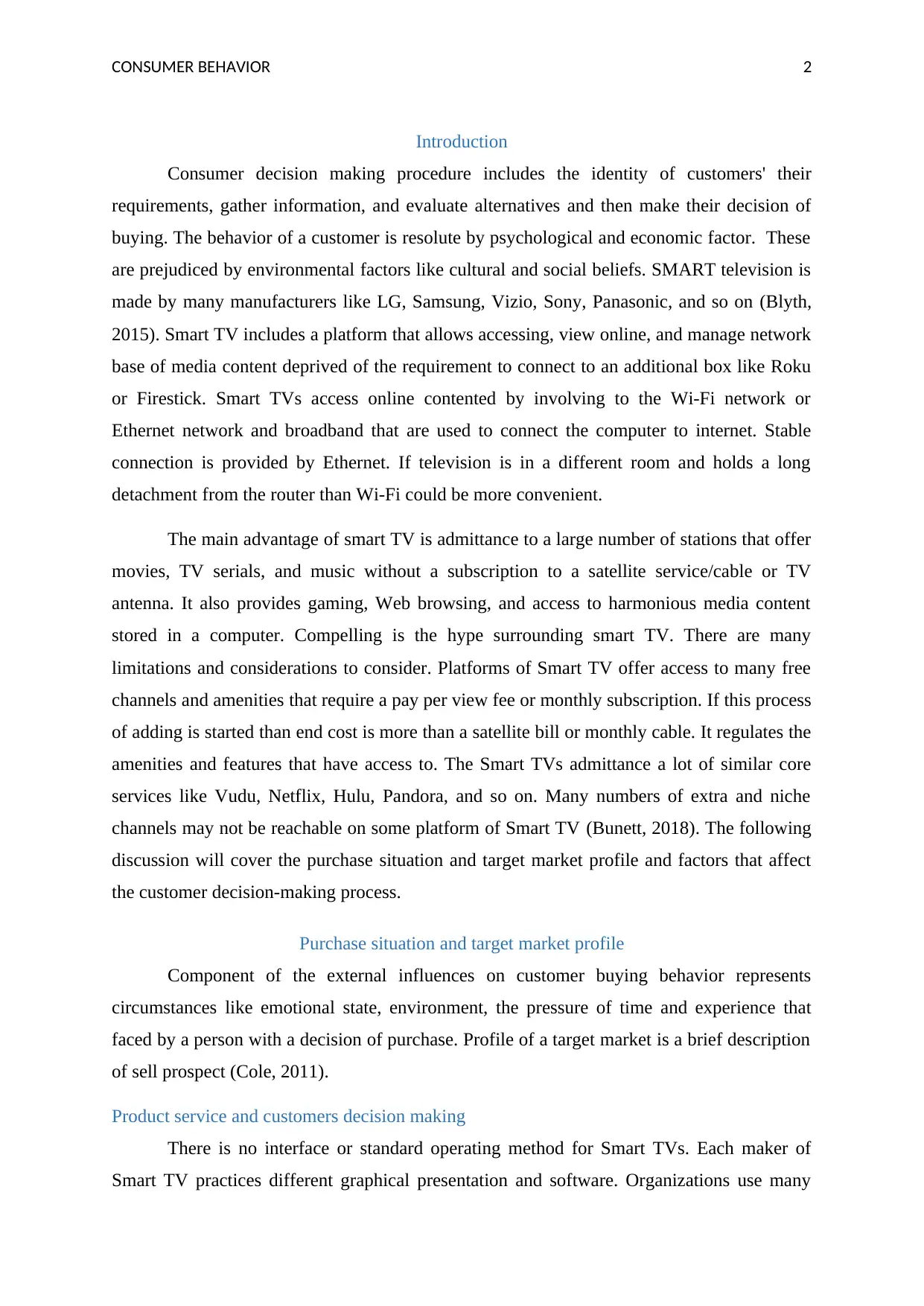
CONSUMER BEHAVIOR 2
Introduction
Consumer decision making procedure includes the identity of customers' their
requirements, gather information, and evaluate alternatives and then make their decision of
buying. The behavior of a customer is resolute by psychological and economic factor. These
are prejudiced by environmental factors like cultural and social beliefs. SMART television is
made by many manufacturers like LG, Samsung, Vizio, Sony, Panasonic, and so on (Blyth,
2015). Smart TV includes a platform that allows accessing, view online, and manage network
base of media content deprived of the requirement to connect to an additional box like Roku
or Firestick. Smart TVs access online contented by involving to the Wi-Fi network or
Ethernet network and broadband that are used to connect the computer to internet. Stable
connection is provided by Ethernet. If television is in a different room and holds a long
detachment from the router than Wi-Fi could be more convenient.
The main advantage of smart TV is admittance to a large number of stations that offer
movies, TV serials, and music without a subscription to a satellite service/cable or TV
antenna. It also provides gaming, Web browsing, and access to harmonious media content
stored in a computer. Compelling is the hype surrounding smart TV. There are many
limitations and considerations to consider. Platforms of Smart TV offer access to many free
channels and amenities that require a pay per view fee or monthly subscription. If this process
of adding is started than end cost is more than a satellite bill or monthly cable. It regulates the
amenities and features that have access to. The Smart TVs admittance a lot of similar core
services like Vudu, Netflix, Hulu, Pandora, and so on. Many numbers of extra and niche
channels may not be reachable on some platform of Smart TV (Bunett, 2018). The following
discussion will cover the purchase situation and target market profile and factors that affect
the customer decision-making process.
Purchase situation and target market profile
Component of the external influences on customer buying behavior represents
circumstances like emotional state, environment, the pressure of time and experience that
faced by a person with a decision of purchase. Profile of a target market is a brief description
of sell prospect (Cole, 2011).
Product service and customers decision making
There is no interface or standard operating method for Smart TVs. Each maker of
Smart TV practices different graphical presentation and software. Organizations use many
Introduction
Consumer decision making procedure includes the identity of customers' their
requirements, gather information, and evaluate alternatives and then make their decision of
buying. The behavior of a customer is resolute by psychological and economic factor. These
are prejudiced by environmental factors like cultural and social beliefs. SMART television is
made by many manufacturers like LG, Samsung, Vizio, Sony, Panasonic, and so on (Blyth,
2015). Smart TV includes a platform that allows accessing, view online, and manage network
base of media content deprived of the requirement to connect to an additional box like Roku
or Firestick. Smart TVs access online contented by involving to the Wi-Fi network or
Ethernet network and broadband that are used to connect the computer to internet. Stable
connection is provided by Ethernet. If television is in a different room and holds a long
detachment from the router than Wi-Fi could be more convenient.
The main advantage of smart TV is admittance to a large number of stations that offer
movies, TV serials, and music without a subscription to a satellite service/cable or TV
antenna. It also provides gaming, Web browsing, and access to harmonious media content
stored in a computer. Compelling is the hype surrounding smart TV. There are many
limitations and considerations to consider. Platforms of Smart TV offer access to many free
channels and amenities that require a pay per view fee or monthly subscription. If this process
of adding is started than end cost is more than a satellite bill or monthly cable. It regulates the
amenities and features that have access to. The Smart TVs admittance a lot of similar core
services like Vudu, Netflix, Hulu, Pandora, and so on. Many numbers of extra and niche
channels may not be reachable on some platform of Smart TV (Bunett, 2018). The following
discussion will cover the purchase situation and target market profile and factors that affect
the customer decision-making process.
Purchase situation and target market profile
Component of the external influences on customer buying behavior represents
circumstances like emotional state, environment, the pressure of time and experience that
faced by a person with a decision of purchase. Profile of a target market is a brief description
of sell prospect (Cole, 2011).
Product service and customers decision making
There is no interface or standard operating method for Smart TVs. Each maker of
Smart TV practices different graphical presentation and software. Organizations use many
⊘ This is a preview!⊘
Do you want full access?
Subscribe today to unlock all pages.

Trusted by 1+ million students worldwide
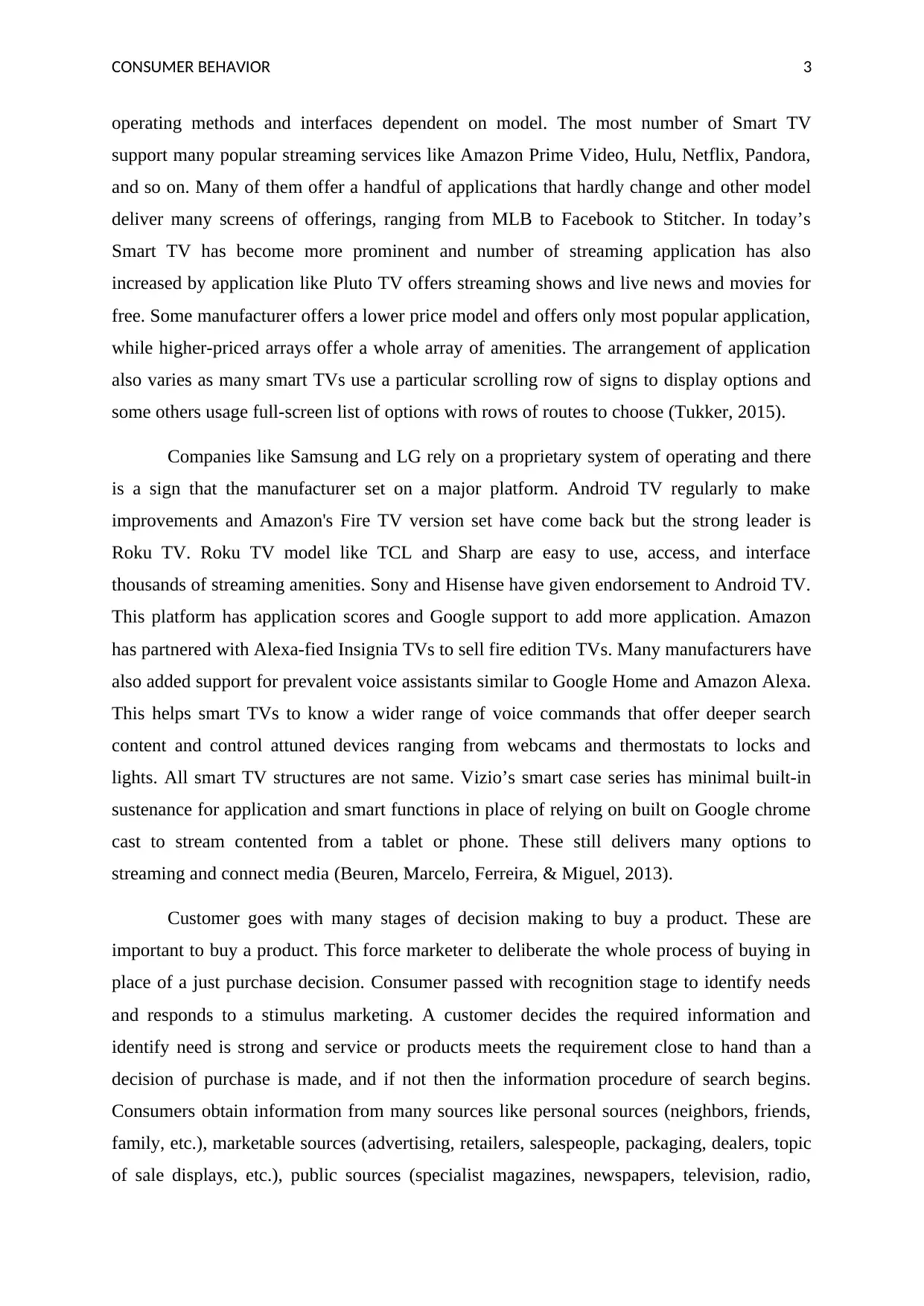
CONSUMER BEHAVIOR 3
operating methods and interfaces dependent on model. The most number of Smart TV
support many popular streaming services like Amazon Prime Video, Hulu, Netflix, Pandora,
and so on. Many of them offer a handful of applications that hardly change and other model
deliver many screens of offerings, ranging from MLB to Facebook to Stitcher. In today’s
Smart TV has become more prominent and number of streaming application has also
increased by application like Pluto TV offers streaming shows and live news and movies for
free. Some manufacturer offers a lower price model and offers only most popular application,
while higher-priced arrays offer a whole array of amenities. The arrangement of application
also varies as many smart TVs use a particular scrolling row of signs to display options and
some others usage full-screen list of options with rows of routes to choose (Tukker, 2015).
Companies like Samsung and LG rely on a proprietary system of operating and there
is a sign that the manufacturer set on a major platform. Android TV regularly to make
improvements and Amazon's Fire TV version set have come back but the strong leader is
Roku TV. Roku TV model like TCL and Sharp are easy to use, access, and interface
thousands of streaming amenities. Sony and Hisense have given endorsement to Android TV.
This platform has application scores and Google support to add more application. Amazon
has partnered with Alexa-fied Insignia TVs to sell fire edition TVs. Many manufacturers have
also added support for prevalent voice assistants similar to Google Home and Amazon Alexa.
This helps smart TVs to know a wider range of voice commands that offer deeper search
content and control attuned devices ranging from webcams and thermostats to locks and
lights. All smart TV structures are not same. Vizio’s smart case series has minimal built-in
sustenance for application and smart functions in place of relying on built on Google chrome
cast to stream contented from a tablet or phone. These still delivers many options to
streaming and connect media (Beuren, Marcelo, Ferreira, & Miguel, 2013).
Customer goes with many stages of decision making to buy a product. These are
important to buy a product. This force marketer to deliberate the whole process of buying in
place of a just purchase decision. Consumer passed with recognition stage to identify needs
and responds to a stimulus marketing. A customer decides the required information and
identify need is strong and service or products meets the requirement close to hand than a
decision of purchase is made, and if not then the information procedure of search begins.
Consumers obtain information from many sources like personal sources (neighbors, friends,
family, etc.), marketable sources (advertising, retailers, salespeople, packaging, dealers, topic
of sale displays, etc.), public sources (specialist magazines, newspapers, television, radio,
operating methods and interfaces dependent on model. The most number of Smart TV
support many popular streaming services like Amazon Prime Video, Hulu, Netflix, Pandora,
and so on. Many of them offer a handful of applications that hardly change and other model
deliver many screens of offerings, ranging from MLB to Facebook to Stitcher. In today’s
Smart TV has become more prominent and number of streaming application has also
increased by application like Pluto TV offers streaming shows and live news and movies for
free. Some manufacturer offers a lower price model and offers only most popular application,
while higher-priced arrays offer a whole array of amenities. The arrangement of application
also varies as many smart TVs use a particular scrolling row of signs to display options and
some others usage full-screen list of options with rows of routes to choose (Tukker, 2015).
Companies like Samsung and LG rely on a proprietary system of operating and there
is a sign that the manufacturer set on a major platform. Android TV regularly to make
improvements and Amazon's Fire TV version set have come back but the strong leader is
Roku TV. Roku TV model like TCL and Sharp are easy to use, access, and interface
thousands of streaming amenities. Sony and Hisense have given endorsement to Android TV.
This platform has application scores and Google support to add more application. Amazon
has partnered with Alexa-fied Insignia TVs to sell fire edition TVs. Many manufacturers have
also added support for prevalent voice assistants similar to Google Home and Amazon Alexa.
This helps smart TVs to know a wider range of voice commands that offer deeper search
content and control attuned devices ranging from webcams and thermostats to locks and
lights. All smart TV structures are not same. Vizio’s smart case series has minimal built-in
sustenance for application and smart functions in place of relying on built on Google chrome
cast to stream contented from a tablet or phone. These still delivers many options to
streaming and connect media (Beuren, Marcelo, Ferreira, & Miguel, 2013).
Customer goes with many stages of decision making to buy a product. These are
important to buy a product. This force marketer to deliberate the whole process of buying in
place of a just purchase decision. Consumer passed with recognition stage to identify needs
and responds to a stimulus marketing. A customer decides the required information and
identify need is strong and service or products meets the requirement close to hand than a
decision of purchase is made, and if not then the information procedure of search begins.
Consumers obtain information from many sources like personal sources (neighbors, friends,
family, etc.), marketable sources (advertising, retailers, salespeople, packaging, dealers, topic
of sale displays, etc.), public sources (specialist magazines, newspapers, television, radio,
Paraphrase This Document
Need a fresh take? Get an instant paraphrase of this document with our AI Paraphraser
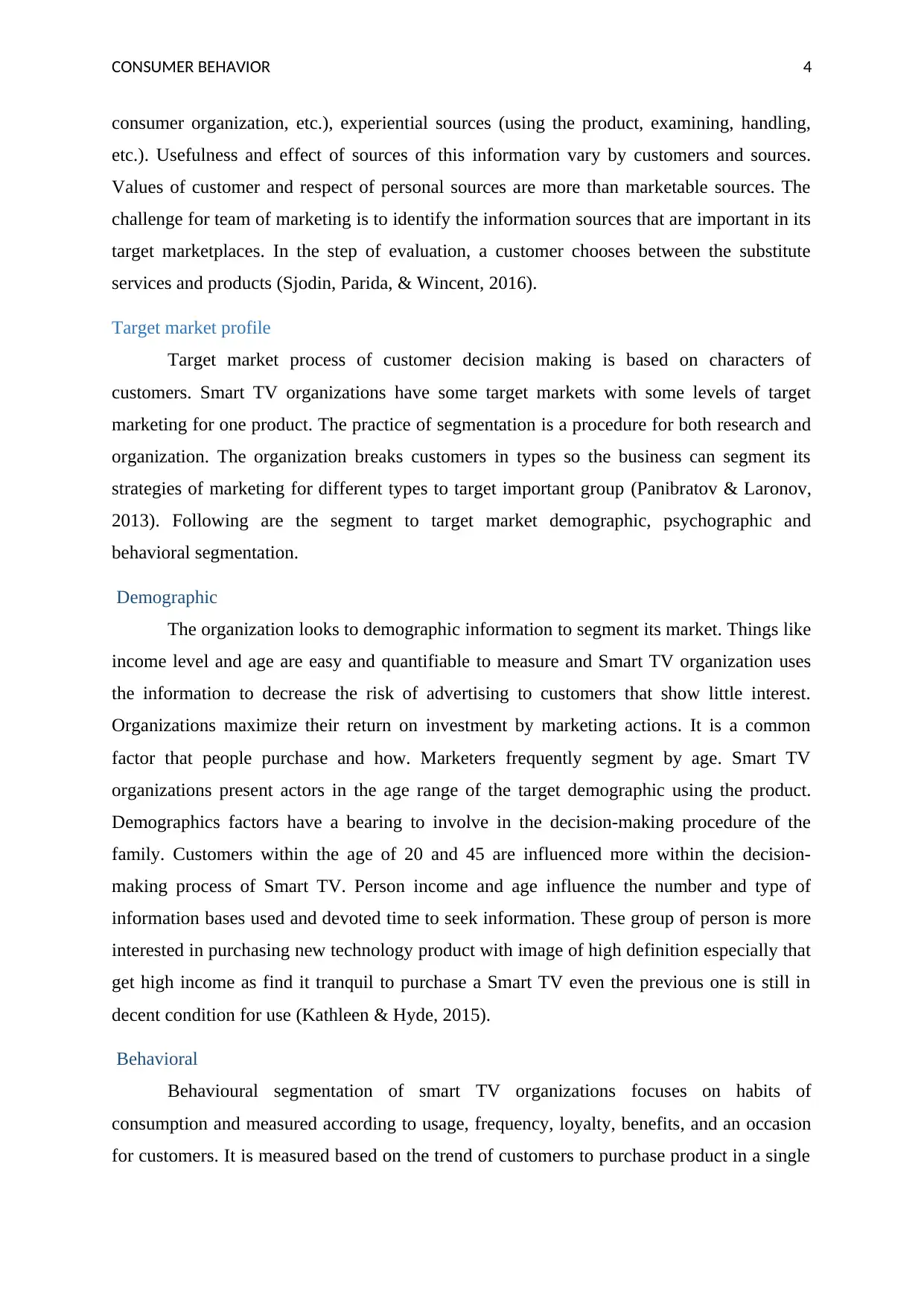
CONSUMER BEHAVIOR 4
consumer organization, etc.), experiential sources (using the product, examining, handling,
etc.). Usefulness and effect of sources of this information vary by customers and sources.
Values of customer and respect of personal sources are more than marketable sources. The
challenge for team of marketing is to identify the information sources that are important in its
target marketplaces. In the step of evaluation, a customer chooses between the substitute
services and products (Sjodin, Parida, & Wincent, 2016).
Target market profile
Target market process of customer decision making is based on characters of
customers. Smart TV organizations have some target markets with some levels of target
marketing for one product. The practice of segmentation is a procedure for both research and
organization. The organization breaks customers in types so the business can segment its
strategies of marketing for different types to target important group (Panibratov & Laronov,
2013). Following are the segment to target market demographic, psychographic and
behavioral segmentation.
Demographic
The organization looks to demographic information to segment its market. Things like
income level and age are easy and quantifiable to measure and Smart TV organization uses
the information to decrease the risk of advertising to customers that show little interest.
Organizations maximize their return on investment by marketing actions. It is a common
factor that people purchase and how. Marketers frequently segment by age. Smart TV
organizations present actors in the age range of the target demographic using the product.
Demographics factors have a bearing to involve in the decision-making procedure of the
family. Customers within the age of 20 and 45 are influenced more within the decision-
making process of Smart TV. Person income and age influence the number and type of
information bases used and devoted time to seek information. These group of person is more
interested in purchasing new technology product with image of high definition especially that
get high income as find it tranquil to purchase a Smart TV even the previous one is still in
decent condition for use (Kathleen & Hyde, 2015).
Behavioral
Behavioural segmentation of smart TV organizations focuses on habits of
consumption and measured according to usage, frequency, loyalty, benefits, and an occasion
for customers. It is measured based on the trend of customers to purchase product in a single
consumer organization, etc.), experiential sources (using the product, examining, handling,
etc.). Usefulness and effect of sources of this information vary by customers and sources.
Values of customer and respect of personal sources are more than marketable sources. The
challenge for team of marketing is to identify the information sources that are important in its
target marketplaces. In the step of evaluation, a customer chooses between the substitute
services and products (Sjodin, Parida, & Wincent, 2016).
Target market profile
Target market process of customer decision making is based on characters of
customers. Smart TV organizations have some target markets with some levels of target
marketing for one product. The practice of segmentation is a procedure for both research and
organization. The organization breaks customers in types so the business can segment its
strategies of marketing for different types to target important group (Panibratov & Laronov,
2013). Following are the segment to target market demographic, psychographic and
behavioral segmentation.
Demographic
The organization looks to demographic information to segment its market. Things like
income level and age are easy and quantifiable to measure and Smart TV organization uses
the information to decrease the risk of advertising to customers that show little interest.
Organizations maximize their return on investment by marketing actions. It is a common
factor that people purchase and how. Marketers frequently segment by age. Smart TV
organizations present actors in the age range of the target demographic using the product.
Demographics factors have a bearing to involve in the decision-making procedure of the
family. Customers within the age of 20 and 45 are influenced more within the decision-
making process of Smart TV. Person income and age influence the number and type of
information bases used and devoted time to seek information. These group of person is more
interested in purchasing new technology product with image of high definition especially that
get high income as find it tranquil to purchase a Smart TV even the previous one is still in
decent condition for use (Kathleen & Hyde, 2015).
Behavioral
Behavioural segmentation of smart TV organizations focuses on habits of
consumption and measured according to usage, frequency, loyalty, benefits, and an occasion
for customers. It is measured based on the trend of customers to purchase product in a single

CONSUMER BEHAVIOR 5
time and spread over a period in short intervals. Many amenities and products offer multiple
benefits. Differentiation of service is necessary to highlight specific benefits (Jabbari &
Kavosi, 2014).
Psychographic segmentation
Opinions, values, lifestyles, activities, and interests are ways to part according to
psychographic segmentation of Smart TV organizations. Marketers of Smart TV alliance
people according to criteria and choose to message that appeal to like and assume according
to things that are based on geographic, demographic, and age factors. The lifestyle of people
associated with marital status, sexual preference and political activism level. Interest values
and opinions are helpful to consider segments of customers and see products according to
market and depend on primarily subjective experiences and opinions of an individual
customer (Wallance, Lings, & Cameron, 2012).
Personal factors
The decision of an individual to purchase a Smart TV is influenced by personal
factors like life cycle state, age, economic situation, personality, style of life, and self-
concept. Customers change during their style of life and purchase products according to their
life stage and age. Factors related to time are food taste, recreation, furniture, and clothing.
Lifestyle, values, environment, hobbies, and habits of customers evolve throughout lifetime.
The Life stages of family change buying behavior and selection of the brand. The life cycle
of a family includes married couples and young singles with children. Marketers of Smart TV
focuses on alternatives, non-traditional stages like same-sex couples, childless couples,
unmarried couples, single parents, and singles marrying later in life. Smart TV organization
assumes that taste of customers change during the lifetime and influenced according to the
selection of brand and different life stages (Akar & Topcu, 2011).
Occupation of a customer and the power of purchasing affects the decision of
purchasing and behavior of purchase. The level of income affects customers of Smart TV that
can pay and afford perspective towards money. A person that share the same occupations and
holds the same taste in actions. They generally socialize by each other than share similar
ideas and values. The higher level of income affects that customer can afford viewpoint
towards money. Individuals that earn lower income are possibly not interested to purchase
this product as it comes in luxury brands. The lifestyle of a customer presents the thinking of
spend money. This is combined from earlier experience, congenital characteristics, and
time and spread over a period in short intervals. Many amenities and products offer multiple
benefits. Differentiation of service is necessary to highlight specific benefits (Jabbari &
Kavosi, 2014).
Psychographic segmentation
Opinions, values, lifestyles, activities, and interests are ways to part according to
psychographic segmentation of Smart TV organizations. Marketers of Smart TV alliance
people according to criteria and choose to message that appeal to like and assume according
to things that are based on geographic, demographic, and age factors. The lifestyle of people
associated with marital status, sexual preference and political activism level. Interest values
and opinions are helpful to consider segments of customers and see products according to
market and depend on primarily subjective experiences and opinions of an individual
customer (Wallance, Lings, & Cameron, 2012).
Personal factors
The decision of an individual to purchase a Smart TV is influenced by personal
factors like life cycle state, age, economic situation, personality, style of life, and self-
concept. Customers change during their style of life and purchase products according to their
life stage and age. Factors related to time are food taste, recreation, furniture, and clothing.
Lifestyle, values, environment, hobbies, and habits of customers evolve throughout lifetime.
The Life stages of family change buying behavior and selection of the brand. The life cycle
of a family includes married couples and young singles with children. Marketers of Smart TV
focuses on alternatives, non-traditional stages like same-sex couples, childless couples,
unmarried couples, single parents, and singles marrying later in life. Smart TV organization
assumes that taste of customers change during the lifetime and influenced according to the
selection of brand and different life stages (Akar & Topcu, 2011).
Occupation of a customer and the power of purchasing affects the decision of
purchasing and behavior of purchase. The level of income affects customers of Smart TV that
can pay and afford perspective towards money. A person that share the same occupations and
holds the same taste in actions. They generally socialize by each other than share similar
ideas and values. The higher level of income affects that customer can afford viewpoint
towards money. Individuals that earn lower income are possibly not interested to purchase
this product as it comes in luxury brands. The lifestyle of a customer presents the thinking of
spend money. This is combined from earlier experience, congenital characteristics, and
⊘ This is a preview!⊘
Do you want full access?
Subscribe today to unlock all pages.

Trusted by 1+ million students worldwide
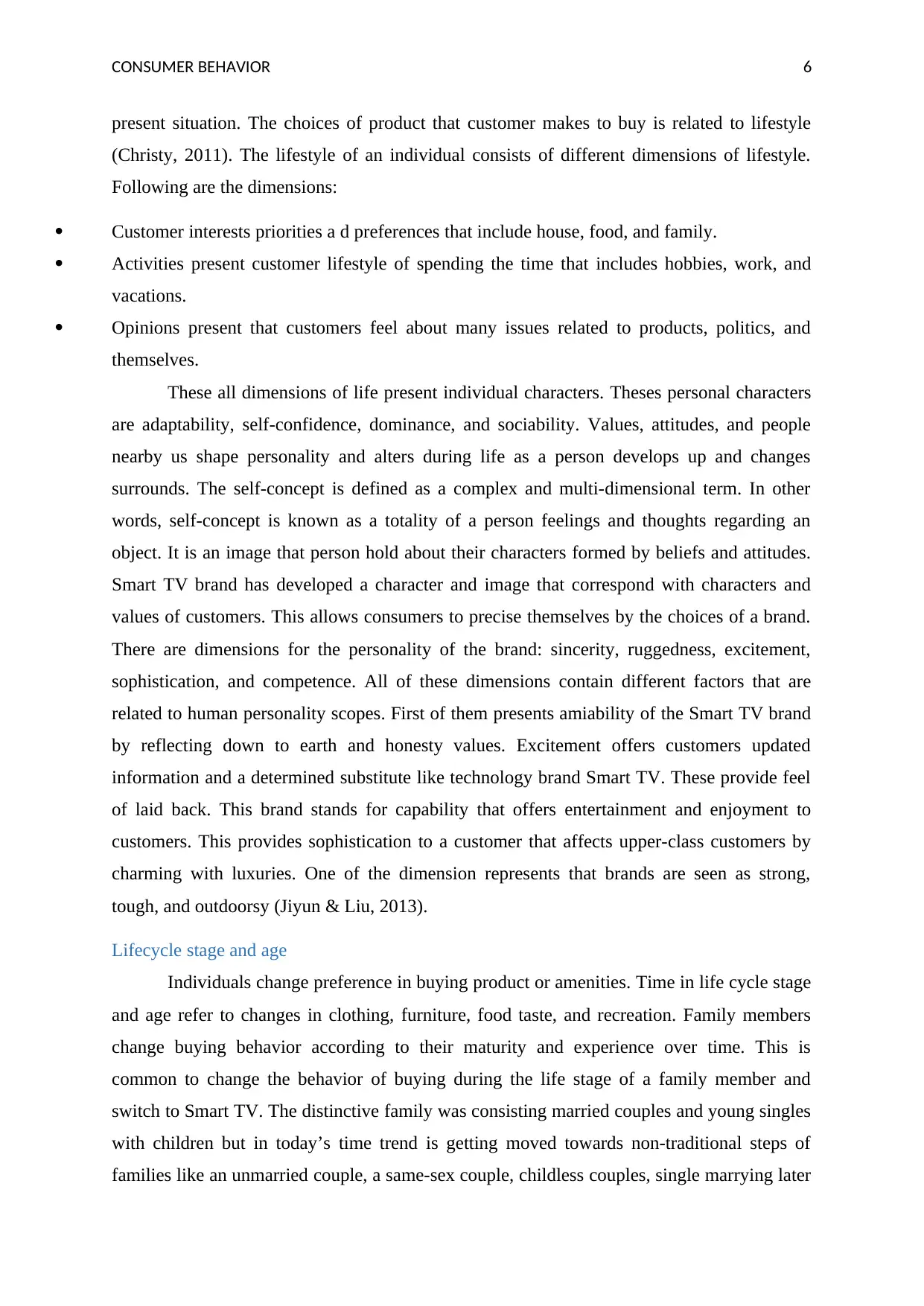
CONSUMER BEHAVIOR 6
present situation. The choices of product that customer makes to buy is related to lifestyle
(Christy, 2011). The lifestyle of an individual consists of different dimensions of lifestyle.
Following are the dimensions:
Customer interests priorities a d preferences that include house, food, and family.
Activities present customer lifestyle of spending the time that includes hobbies, work, and
vacations.
Opinions present that customers feel about many issues related to products, politics, and
themselves.
These all dimensions of life present individual characters. Theses personal characters
are adaptability, self-confidence, dominance, and sociability. Values, attitudes, and people
nearby us shape personality and alters during life as a person develops up and changes
surrounds. The self-concept is defined as a complex and multi-dimensional term. In other
words, self-concept is known as a totality of a person feelings and thoughts regarding an
object. It is an image that person hold about their characters formed by beliefs and attitudes.
Smart TV brand has developed a character and image that correspond with characters and
values of customers. This allows consumers to precise themselves by the choices of a brand.
There are dimensions for the personality of the brand: sincerity, ruggedness, excitement,
sophistication, and competence. All of these dimensions contain different factors that are
related to human personality scopes. First of them presents amiability of the Smart TV brand
by reflecting down to earth and honesty values. Excitement offers customers updated
information and a determined substitute like technology brand Smart TV. These provide feel
of laid back. This brand stands for capability that offers entertainment and enjoyment to
customers. This provides sophistication to a customer that affects upper-class customers by
charming with luxuries. One of the dimension represents that brands are seen as strong,
tough, and outdoorsy (Jiyun & Liu, 2013).
Lifecycle stage and age
Individuals change preference in buying product or amenities. Time in life cycle stage
and age refer to changes in clothing, furniture, food taste, and recreation. Family members
change buying behavior according to their maturity and experience over time. This is
common to change the behavior of buying during the life stage of a family member and
switch to Smart TV. The distinctive family was consisting married couples and young singles
with children but in today’s time trend is getting moved towards non-traditional steps of
families like an unmarried couple, a same-sex couple, childless couples, single marrying later
present situation. The choices of product that customer makes to buy is related to lifestyle
(Christy, 2011). The lifestyle of an individual consists of different dimensions of lifestyle.
Following are the dimensions:
Customer interests priorities a d preferences that include house, food, and family.
Activities present customer lifestyle of spending the time that includes hobbies, work, and
vacations.
Opinions present that customers feel about many issues related to products, politics, and
themselves.
These all dimensions of life present individual characters. Theses personal characters
are adaptability, self-confidence, dominance, and sociability. Values, attitudes, and people
nearby us shape personality and alters during life as a person develops up and changes
surrounds. The self-concept is defined as a complex and multi-dimensional term. In other
words, self-concept is known as a totality of a person feelings and thoughts regarding an
object. It is an image that person hold about their characters formed by beliefs and attitudes.
Smart TV brand has developed a character and image that correspond with characters and
values of customers. This allows consumers to precise themselves by the choices of a brand.
There are dimensions for the personality of the brand: sincerity, ruggedness, excitement,
sophistication, and competence. All of these dimensions contain different factors that are
related to human personality scopes. First of them presents amiability of the Smart TV brand
by reflecting down to earth and honesty values. Excitement offers customers updated
information and a determined substitute like technology brand Smart TV. These provide feel
of laid back. This brand stands for capability that offers entertainment and enjoyment to
customers. This provides sophistication to a customer that affects upper-class customers by
charming with luxuries. One of the dimension represents that brands are seen as strong,
tough, and outdoorsy (Jiyun & Liu, 2013).
Lifecycle stage and age
Individuals change preference in buying product or amenities. Time in life cycle stage
and age refer to changes in clothing, furniture, food taste, and recreation. Family members
change buying behavior according to their maturity and experience over time. This is
common to change the behavior of buying during the life stage of a family member and
switch to Smart TV. The distinctive family was consisting married couples and young singles
with children but in today’s time trend is getting moved towards non-traditional steps of
families like an unmarried couple, a same-sex couple, childless couples, single marrying later
Paraphrase This Document
Need a fresh take? Get an instant paraphrase of this document with our AI Paraphraser
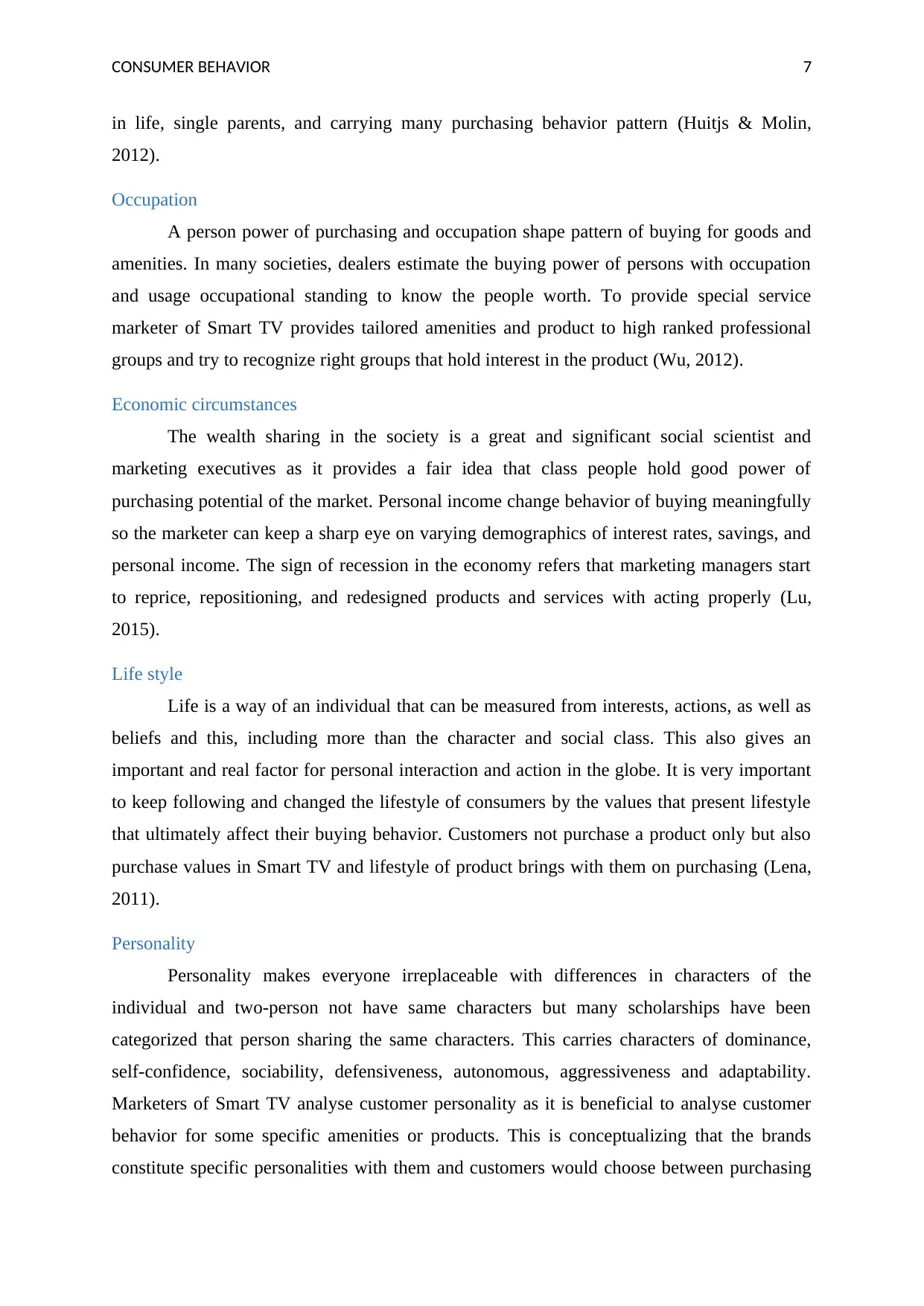
CONSUMER BEHAVIOR 7
in life, single parents, and carrying many purchasing behavior pattern (Huitjs & Molin,
2012).
Occupation
A person power of purchasing and occupation shape pattern of buying for goods and
amenities. In many societies, dealers estimate the buying power of persons with occupation
and usage occupational standing to know the people worth. To provide special service
marketer of Smart TV provides tailored amenities and product to high ranked professional
groups and try to recognize right groups that hold interest in the product (Wu, 2012).
Economic circumstances
The wealth sharing in the society is a great and significant social scientist and
marketing executives as it provides a fair idea that class people hold good power of
purchasing potential of the market. Personal income change behavior of buying meaningfully
so the marketer can keep a sharp eye on varying demographics of interest rates, savings, and
personal income. The sign of recession in the economy refers that marketing managers start
to reprice, repositioning, and redesigned products and services with acting properly (Lu,
2015).
Life style
Life is a way of an individual that can be measured from interests, actions, as well as
beliefs and this, including more than the character and social class. This also gives an
important and real factor for personal interaction and action in the globe. It is very important
to keep following and changed the lifestyle of consumers by the values that present lifestyle
that ultimately affect their buying behavior. Customers not purchase a product only but also
purchase values in Smart TV and lifestyle of product brings with them on purchasing (Lena,
2011).
Personality
Personality makes everyone irreplaceable with differences in characters of the
individual and two-person not have same characters but many scholarships have been
categorized that person sharing the same characters. This carries characters of dominance,
self-confidence, sociability, defensiveness, autonomous, aggressiveness and adaptability.
Marketers of Smart TV analyse customer personality as it is beneficial to analyse customer
behavior for some specific amenities or products. This is conceptualizing that the brands
constitute specific personalities with them and customers would choose between purchasing
in life, single parents, and carrying many purchasing behavior pattern (Huitjs & Molin,
2012).
Occupation
A person power of purchasing and occupation shape pattern of buying for goods and
amenities. In many societies, dealers estimate the buying power of persons with occupation
and usage occupational standing to know the people worth. To provide special service
marketer of Smart TV provides tailored amenities and product to high ranked professional
groups and try to recognize right groups that hold interest in the product (Wu, 2012).
Economic circumstances
The wealth sharing in the society is a great and significant social scientist and
marketing executives as it provides a fair idea that class people hold good power of
purchasing potential of the market. Personal income change behavior of buying meaningfully
so the marketer can keep a sharp eye on varying demographics of interest rates, savings, and
personal income. The sign of recession in the economy refers that marketing managers start
to reprice, repositioning, and redesigned products and services with acting properly (Lu,
2015).
Life style
Life is a way of an individual that can be measured from interests, actions, as well as
beliefs and this, including more than the character and social class. This also gives an
important and real factor for personal interaction and action in the globe. It is very important
to keep following and changed the lifestyle of consumers by the values that present lifestyle
that ultimately affect their buying behavior. Customers not purchase a product only but also
purchase values in Smart TV and lifestyle of product brings with them on purchasing (Lena,
2011).
Personality
Personality makes everyone irreplaceable with differences in characters of the
individual and two-person not have same characters but many scholarships have been
categorized that person sharing the same characters. This carries characters of dominance,
self-confidence, sociability, defensiveness, autonomous, aggressiveness and adaptability.
Marketers of Smart TV analyse customer personality as it is beneficial to analyse customer
behavior for some specific amenities or products. This is conceptualizing that the brands
constitute specific personalities with them and customers would choose between purchasing
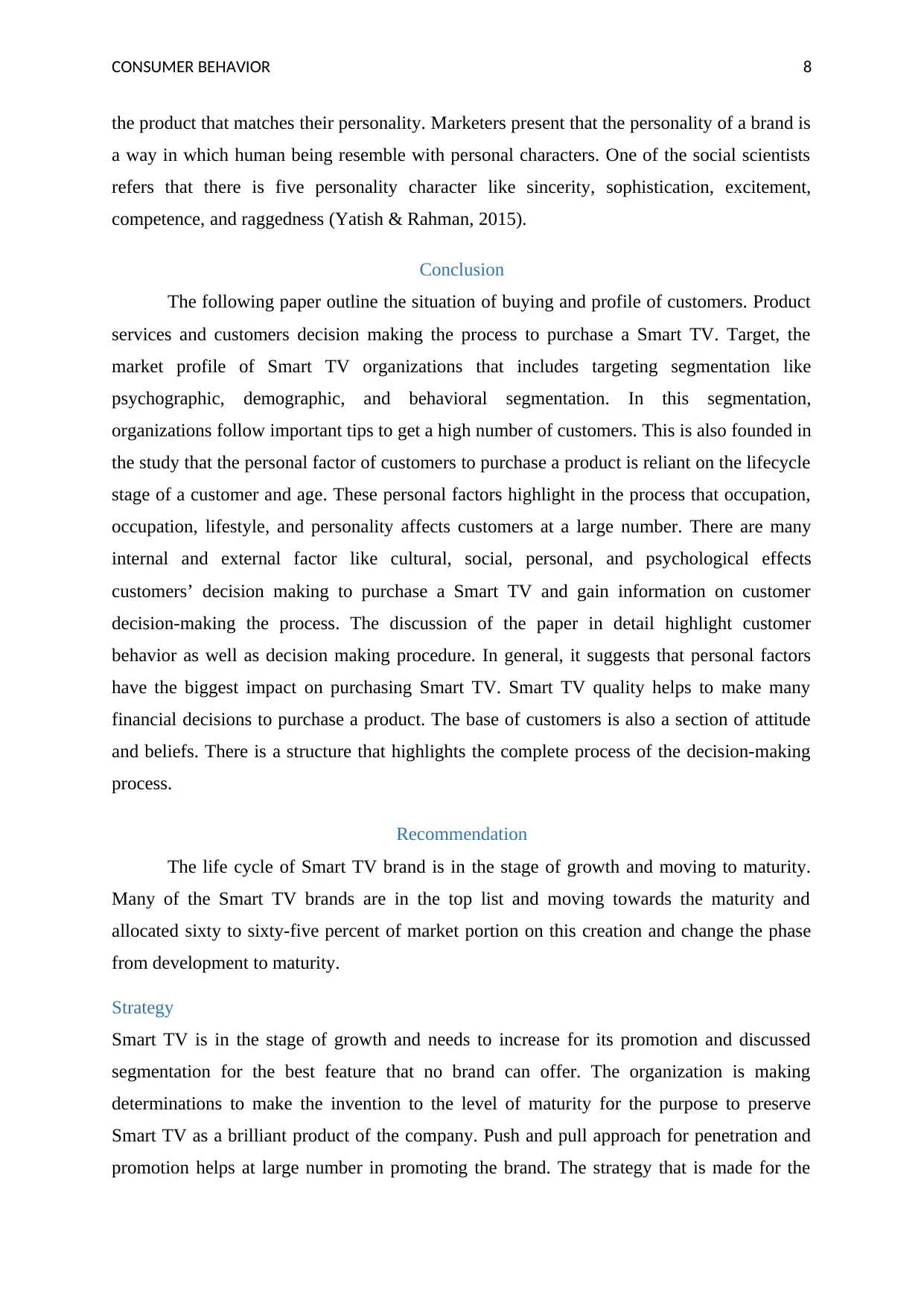
CONSUMER BEHAVIOR 8
the product that matches their personality. Marketers present that the personality of a brand is
a way in which human being resemble with personal characters. One of the social scientists
refers that there is five personality character like sincerity, sophistication, excitement,
competence, and raggedness (Yatish & Rahman, 2015).
Conclusion
The following paper outline the situation of buying and profile of customers. Product
services and customers decision making the process to purchase a Smart TV. Target, the
market profile of Smart TV organizations that includes targeting segmentation like
psychographic, demographic, and behavioral segmentation. In this segmentation,
organizations follow important tips to get a high number of customers. This is also founded in
the study that the personal factor of customers to purchase a product is reliant on the lifecycle
stage of a customer and age. These personal factors highlight in the process that occupation,
occupation, lifestyle, and personality affects customers at a large number. There are many
internal and external factor like cultural, social, personal, and psychological effects
customers’ decision making to purchase a Smart TV and gain information on customer
decision-making the process. The discussion of the paper in detail highlight customer
behavior as well as decision making procedure. In general, it suggests that personal factors
have the biggest impact on purchasing Smart TV. Smart TV quality helps to make many
financial decisions to purchase a product. The base of customers is also a section of attitude
and beliefs. There is a structure that highlights the complete process of the decision-making
process.
Recommendation
The life cycle of Smart TV brand is in the stage of growth and moving to maturity.
Many of the Smart TV brands are in the top list and moving towards the maturity and
allocated sixty to sixty-five percent of market portion on this creation and change the phase
from development to maturity.
Strategy
Smart TV is in the stage of growth and needs to increase for its promotion and discussed
segmentation for the best feature that no brand can offer. The organization is making
determinations to make the invention to the level of maturity for the purpose to preserve
Smart TV as a brilliant product of the company. Push and pull approach for penetration and
promotion helps at large number in promoting the brand. The strategy that is made for the
the product that matches their personality. Marketers present that the personality of a brand is
a way in which human being resemble with personal characters. One of the social scientists
refers that there is five personality character like sincerity, sophistication, excitement,
competence, and raggedness (Yatish & Rahman, 2015).
Conclusion
The following paper outline the situation of buying and profile of customers. Product
services and customers decision making the process to purchase a Smart TV. Target, the
market profile of Smart TV organizations that includes targeting segmentation like
psychographic, demographic, and behavioral segmentation. In this segmentation,
organizations follow important tips to get a high number of customers. This is also founded in
the study that the personal factor of customers to purchase a product is reliant on the lifecycle
stage of a customer and age. These personal factors highlight in the process that occupation,
occupation, lifestyle, and personality affects customers at a large number. There are many
internal and external factor like cultural, social, personal, and psychological effects
customers’ decision making to purchase a Smart TV and gain information on customer
decision-making the process. The discussion of the paper in detail highlight customer
behavior as well as decision making procedure. In general, it suggests that personal factors
have the biggest impact on purchasing Smart TV. Smart TV quality helps to make many
financial decisions to purchase a product. The base of customers is also a section of attitude
and beliefs. There is a structure that highlights the complete process of the decision-making
process.
Recommendation
The life cycle of Smart TV brand is in the stage of growth and moving to maturity.
Many of the Smart TV brands are in the top list and moving towards the maturity and
allocated sixty to sixty-five percent of market portion on this creation and change the phase
from development to maturity.
Strategy
Smart TV is in the stage of growth and needs to increase for its promotion and discussed
segmentation for the best feature that no brand can offer. The organization is making
determinations to make the invention to the level of maturity for the purpose to preserve
Smart TV as a brilliant product of the company. Push and pull approach for penetration and
promotion helps at large number in promoting the brand. The strategy that is made for the
⊘ This is a preview!⊘
Do you want full access?
Subscribe today to unlock all pages.

Trusted by 1+ million students worldwide
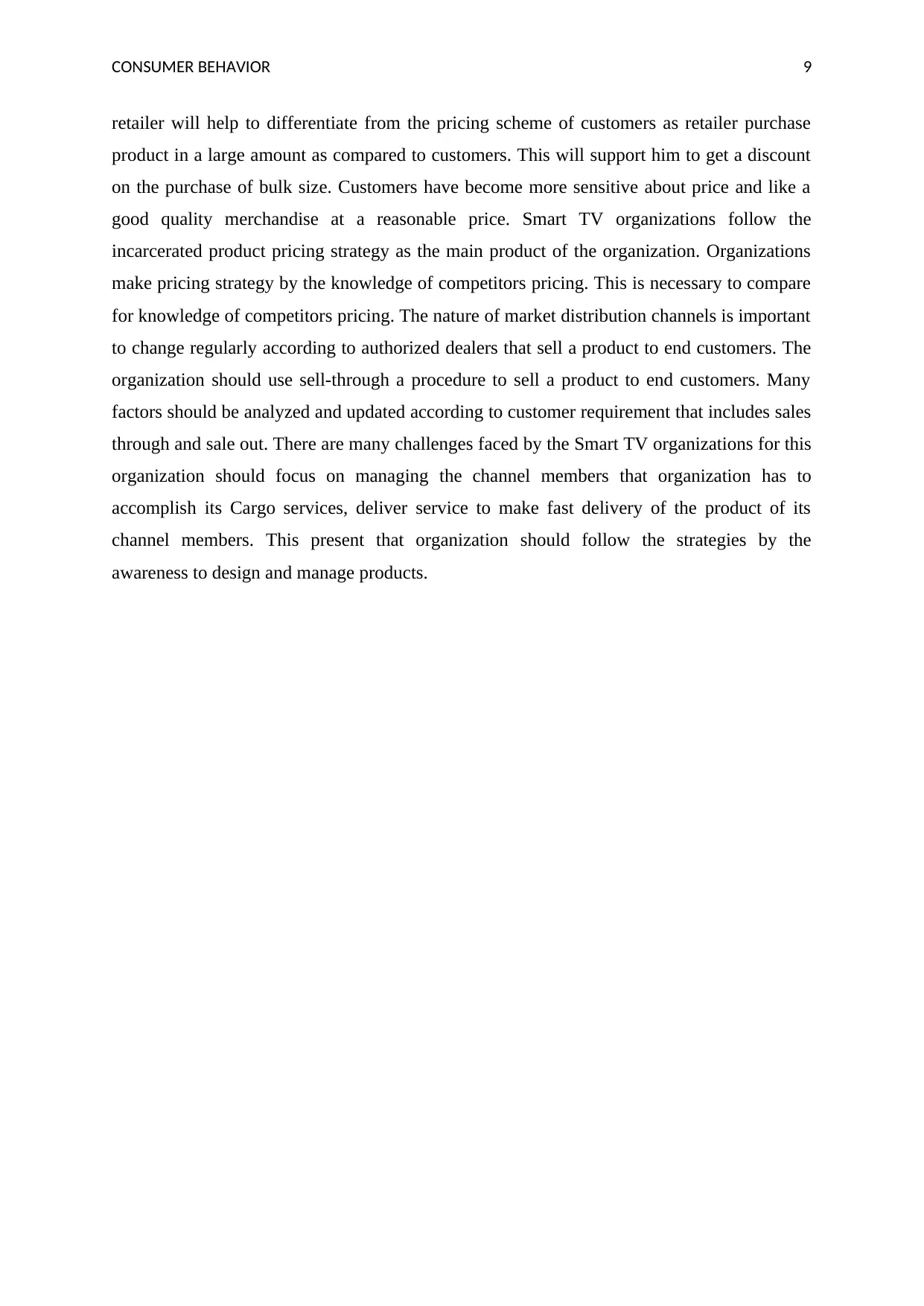
CONSUMER BEHAVIOR 9
retailer will help to differentiate from the pricing scheme of customers as retailer purchase
product in a large amount as compared to customers. This will support him to get a discount
on the purchase of bulk size. Customers have become more sensitive about price and like a
good quality merchandise at a reasonable price. Smart TV organizations follow the
incarcerated product pricing strategy as the main product of the organization. Organizations
make pricing strategy by the knowledge of competitors pricing. This is necessary to compare
for knowledge of competitors pricing. The nature of market distribution channels is important
to change regularly according to authorized dealers that sell a product to end customers. The
organization should use sell-through a procedure to sell a product to end customers. Many
factors should be analyzed and updated according to customer requirement that includes sales
through and sale out. There are many challenges faced by the Smart TV organizations for this
organization should focus on managing the channel members that organization has to
accomplish its Cargo services, deliver service to make fast delivery of the product of its
channel members. This present that organization should follow the strategies by the
awareness to design and manage products.
retailer will help to differentiate from the pricing scheme of customers as retailer purchase
product in a large amount as compared to customers. This will support him to get a discount
on the purchase of bulk size. Customers have become more sensitive about price and like a
good quality merchandise at a reasonable price. Smart TV organizations follow the
incarcerated product pricing strategy as the main product of the organization. Organizations
make pricing strategy by the knowledge of competitors pricing. This is necessary to compare
for knowledge of competitors pricing. The nature of market distribution channels is important
to change regularly according to authorized dealers that sell a product to end customers. The
organization should use sell-through a procedure to sell a product to end customers. Many
factors should be analyzed and updated according to customer requirement that includes sales
through and sale out. There are many challenges faced by the Smart TV organizations for this
organization should focus on managing the channel members that organization has to
accomplish its Cargo services, deliver service to make fast delivery of the product of its
channel members. This present that organization should follow the strategies by the
awareness to design and manage products.
Paraphrase This Document
Need a fresh take? Get an instant paraphrase of this document with our AI Paraphraser

CONSUMER BEHAVIOR 10
References
Akar, E., & Topcu, B. (2011). Factors Influence Customer Decision-Making Process.
Journal of Internet Commerce, 10(01), 35-67.
Beuren, F., Marcelo, G., Ferreira, P., & Miguel, C. (2013). System of Product
Services. Journal of Business Management, 47(04), 222-231.
Blyth, J. (2015). Essential For Marketing. UK: Routledge.
Bunett, J. (2018). The core concept of Marketing. New York: Mc-Graw Hill.
Christy, A. (2011). Relationship Marketing Engagement. Journal of Business
Research, 64(07), 749-756.
Cole, A. (2011). The Decision of Purchase. Journal of Business Ethics, 59(06), 59-96.
Huitjs, N., & Molin, E. (2012). Technology Acceptance. International Journal of
Business Ethics, 31(06), 525-531.
Jabbari, A., & Kavosi, Z. (2014). Behavioral Segmentation. International Journal of
Disaster Management, 04(02), 232.
Jiyun, K., & Liu, C. (2013). Sustainability. International Journal of Customer
Studies, 37(04), 442-482.
Kathleen, K., & Hyde, J. (2015). Demographic Segmentation. International Journal
of Business Statistic, 59(06), 49-61.
Lena, L. (2011). Entrepreneurial. Journal of Business Venturing, 26(01), 124-136.
Lu, H.-P. (2015). Persuasive Messages. Journal of Business Research, 26(05), 777-
782.
Panibratov, J., & Laronov, A. (2013). Target Market Profile. World Applied Science
Journal, 23(13), 144-148.
Sjodin, D. R., Parida, V., & Wincent, J. (2016). Relational Coping Strategy. Journal
of Industrial Marketing Management, 56(09), 108-119.
Tukker, A. (2015). Product Services For a Resource. Journal of Cleaner Production,
97(06), 76-91.
References
Akar, E., & Topcu, B. (2011). Factors Influence Customer Decision-Making Process.
Journal of Internet Commerce, 10(01), 35-67.
Beuren, F., Marcelo, G., Ferreira, P., & Miguel, C. (2013). System of Product
Services. Journal of Business Management, 47(04), 222-231.
Blyth, J. (2015). Essential For Marketing. UK: Routledge.
Bunett, J. (2018). The core concept of Marketing. New York: Mc-Graw Hill.
Christy, A. (2011). Relationship Marketing Engagement. Journal of Business
Research, 64(07), 749-756.
Cole, A. (2011). The Decision of Purchase. Journal of Business Ethics, 59(06), 59-96.
Huitjs, N., & Molin, E. (2012). Technology Acceptance. International Journal of
Business Ethics, 31(06), 525-531.
Jabbari, A., & Kavosi, Z. (2014). Behavioral Segmentation. International Journal of
Disaster Management, 04(02), 232.
Jiyun, K., & Liu, C. (2013). Sustainability. International Journal of Customer
Studies, 37(04), 442-482.
Kathleen, K., & Hyde, J. (2015). Demographic Segmentation. International Journal
of Business Statistic, 59(06), 49-61.
Lena, L. (2011). Entrepreneurial. Journal of Business Venturing, 26(01), 124-136.
Lu, H.-P. (2015). Persuasive Messages. Journal of Business Research, 26(05), 777-
782.
Panibratov, J., & Laronov, A. (2013). Target Market Profile. World Applied Science
Journal, 23(13), 144-148.
Sjodin, D. R., Parida, V., & Wincent, J. (2016). Relational Coping Strategy. Journal
of Industrial Marketing Management, 56(09), 108-119.
Tukker, A. (2015). Product Services For a Resource. Journal of Cleaner Production,
97(06), 76-91.

CONSUMER BEHAVIOR 11
Wallance, M., Lings, I., & Cameron, R. (2012). Psychographic Segmentation. Asia
Pacific Journal of Human Resources, 50(04), 483-502.
Wu, S.-H. (2012). Identification Affect. Journal of Sport Management, 26(02), 177-
191.
Yatish, J., & Rahman, Z. (2015). Factors Affect Behavior. Journal of International
Strategic Management, 03(01), 128-143.
Wallance, M., Lings, I., & Cameron, R. (2012). Psychographic Segmentation. Asia
Pacific Journal of Human Resources, 50(04), 483-502.
Wu, S.-H. (2012). Identification Affect. Journal of Sport Management, 26(02), 177-
191.
Yatish, J., & Rahman, Z. (2015). Factors Affect Behavior. Journal of International
Strategic Management, 03(01), 128-143.
⊘ This is a preview!⊘
Do you want full access?
Subscribe today to unlock all pages.

Trusted by 1+ million students worldwide
1 out of 12
Your All-in-One AI-Powered Toolkit for Academic Success.
+13062052269
info@desklib.com
Available 24*7 on WhatsApp / Email
![[object Object]](/_next/static/media/star-bottom.7253800d.svg)
Unlock your academic potential
Copyright © 2020–2025 A2Z Services. All Rights Reserved. Developed and managed by ZUCOL.
